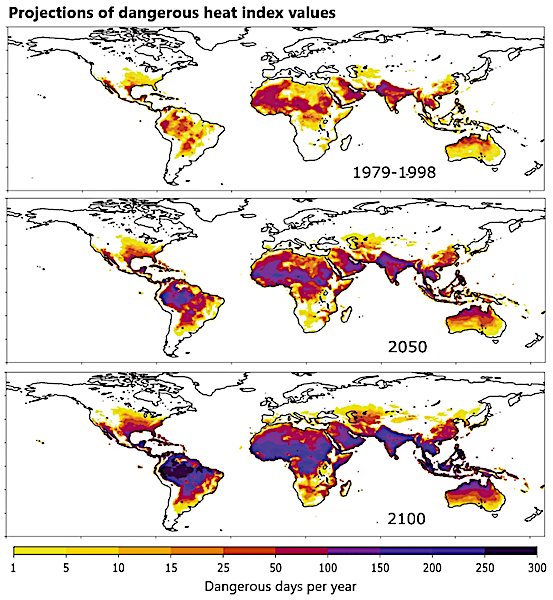Search
Democracy Links
Member's Off-site Blogs
cool your body down, or you die…….

As global temperatures rise, people in the tropics, including places like India and Africa’s Sahel region, will likely face dangerously hot conditions almost daily by the end of the century – even as the world reduces its greenhouse gas emissions, a new study shows.
The mid-latitudes, including the U.S., will also face increasing risks. There, the number of dangerously hot days, marked by temperatures and humidity high enough to cause heat exhaustion, is projected to double by the 2050s and continue to rise.
By David Battisti, University of Washington
In the study, scientists looked at population growth, economic development patterns, energy choices and climate models to project how heat index levels – the combination of heat and humidity – will change over time. The Conversation asked University of Washington atmospheric scientist David Battisti, a co-author of the study, published Aug. 25, 2022, to explain the findings and what they mean for humans around the world.
What does the new study tell us about heat waves in the future, and importantly the impact on people?There are two sources of uncertainty when it comes to future temperature. One is how much carbon dioxide humans are going to emit – that depends on things like population, energy choices and how much the economy grows. The other is how much warming those greenhouse gas emissions will cause.
In both, scientists have a really good sense of the likelihood of various scenarios. For this study, we combined those estimates to get a likelihood in the future of having dangerous and life-threatening temperatures.
We looked at what these “dangerously high” and “extremely dangerous” levels on the heat index would mean for daily life in both the tropics and in the mid-latitudes.
“Dangerous” in this case refers to the likelihood of heat exhaustion. Heat exhaustion won’t kill you if you’re able to stop and slow down – it’s characterized by fatigue, nausea, a slowed heartbeat, possibly fainting. But you really can’t work under these conditions.
The heat index indicates when a person is likely to reach that threshold. The National Weather Service defines “dangerous” as a heat index of 103 F (39.4 C), and “extremely dangerous” as 125 F (51.7 C). If a person gets to “extremely dangerous” temperatures, that can lead to heat stroke. At that level, you have a few hours to get medical attention to cool your body down, or you die.
READ MORE:
GUSNOTE: THE PROBABILITY OF HOT DAYS IN THE MAP ABOVE IS SOMEWHAT MISLEADING. IT IS PRESENTLY OBSERVED THAT DANGEROUS HEAT WAVES DO AFFECT REGIONS WHICH ARE NOT MARKED ON THE MAP ABOVE. IN PREVIOUS ANALYSIS PRESENTED BY GUS ON THIS SITE, THE PRESENT TEMPERATE REGIONS (EUROPE, USA, CHINA) ARE LIKELY TO SUFFER FAR MORE FROM HEAT WAVES THAN SAY THE EQUATORIAL REGION OR THE TROPICS. POLAR REGION WILL ALSO EXPERIENCE STRONGER HEAT WAVES THAN TEMPERATE REGIONS, BUT BECAUSE THEIR TEMPERATURE IS LOW, THE HEAT WON'T BE "DANGEROUS" (EXCEPT FOR POLAR BEARS?)....
THE MOST DANGEROUS HEAT WAVES WILL HAPPEN IN HIGHLY POPULATED AREAS IN AUSTRALIA (THE CENTRE IS ALREADY HOT), ESPECIALLY THE SYDNEY REGION, WHERE WE KNOW UNOFFICIAL SCIENTIFICALLY RECORDED TEMPERATURES WENT ABOVE 50 DEGREES CELSIUS A COUPLE OF YEARS AGO, WHEN THE PENRITH SUBURB WAS DECLARED THE HOTTEST PLACE ON EARTH WITH 49+ DEGREES CELSIUS...
MEANWHILE SYDNEY HAS BEATEN ALL RECORDS FOR RAIN THIS YEAR.....
FREE JULIAN ASSANGE NOW........................
- By Gus Leonisky at 30 Aug 2022 - 6:38am
- Gus Leonisky's blog
- Login or register to post comments
Recent comments
9 hours 21 min ago
10 hours 28 min ago
12 hours 6 min ago
12 hours 15 min ago
13 hours 2 min ago
13 hours 7 min ago
13 hours 10 min ago
14 hours 55 min ago
17 hours 40 min ago
1 day 6 hours ago